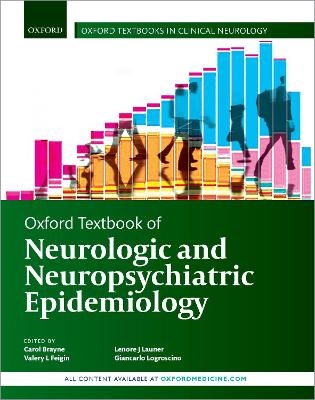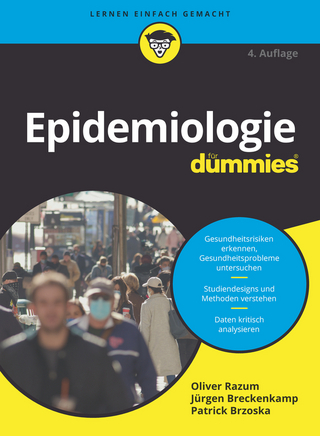
Oxford Textbook of Neurologic and Neuropsychiatric Epidemiology
Oxford University Press (Verlag)
978-0-19-874949-3 (ISBN)
Neurologic and neuropsychiatric disorders are of great importance to societies and they also raise special considerations in epidemiological research methodology. Not only do neurologic and neuropsychiatric disorders form a major group of disorders associated with ageing populations, but those disorders that occur in earlier life can be associated with severe individual, family, and societal distress and burden. The inter-relationship of syndromes and disorders is a topic of major interest and growing biological insights across psychiatry and neurology. This includes not only overlaps in neurodegenerative syndromes but also those related to other systems such as metabolic, inflammatory, immune and vascular disorders.
Part of the Oxford Textbooks in Clinical Neurology series, the Oxford Textbook of Neurologic and Neuropsychiatric Epidemiology is designed to focus on the overlaps and inter-relationships between neuro-epidemiological disorders, as well as on ways to harmonise large cohort studies to maximise opportunities for determining causes related to rarer disorders. Divided into three main parts, the book covers 1) the principles of neurologic and neuropsychiatric epidemiology; 2) specific neuropsychiatric disorders and their inter-relationships and 3) the implications of neuro-epidemiologic research for patient populations and current medical practice. This comprehensive work serves as an invaluable reference to current neuro-epidemiological methods for neurologists, psychiatrists, and senior trainees in those disciplines, as well as public health practitioners and students with an interest in neurology and neuropsychiatry.
Carol Brayne CBE is Professor of Public Health Medicine at the University of Cambridge and Director of the Cambridge Institute of Public Health. Graduating from the Royal Free Hospital School of Medicine at the University of London in 1981, she went on to train in general medicine from 1982-1983. Since then, her work has been focused around longitudinal studies of the neurological health of older people from a public health perspective. Since joining Cambridge, she has been appointed chair of the Faculty of Public Health, Academic & Research Comittee, CLAHRC theme lead, Special Adivsor to the Royal College of Physicians, fellow of the Academy of Sciences, and co-chair of the Alzherimer's Society Research Strategy Council. Listed among the highest cited scholars in the world in 2018, Professor Brayne was awarded a CBE for services to public health medicine in the Queen's 2017 Honours. Professor Valery Feigin is the director of Auckland University of Technology's National Institute for Stroke and Applied Neuroscience (NISAN), associate director of the Centre for Neurocomputation and Brain Study at KEDRI, and affiliate professor of the Department of Global Health at the Institute for Health Metrics and Evaluation at the University of Washington. A current board member of the World Stroke Organisation, Professor Feigin's work focuses predominantly on stroke, TBI, treatment, and epidemiology. He has authored or co-authored over 600 academic publications, and been cited over 31,000 times, and currently serves as Editor-in-Chief of the journal Neuroepidemiology. Feigin has received numerous awards over his career, including the Bruce Shoenburh International Award and Lecture in Neuropepidemiology, the Fogarty International Centre Research Grant Award, and the World Stroke Organization President's award for his services to stroke research. Dr. Launer is a senior investigator at the National Institute on Aging in Bethesda, Maryland. In 1987, she received her PhD in Epidemiology and Nutrition from Cornell University, after which she undertook a three year post-doctoral fellowship at NICHD. She has held positions at the National Insitute of Health and the Environment and Erasmus University, where she led and was involved with numerous large-scale epidemiological studies into dementia and migraine. Since 1999, she has led the Neuroepidemiology section of the NIA Laboratory of Epidemiology, Demography, and Biometry, where she has researched the genetic, inflammatory, vascular, metabolic, and hormonal factors of sub-clinical and clinical outcomes in brain disease. Giancarlo Logroscino, MD PhD is Professor of Neurology and director of the Neurodegenerative Diseases Unit at The University of Bari, and Chair of the Department of Clinical Research in Neurology at Pia Fondazione Panico in Tricase (LE). His primary research interests are natural history of neurodegenerative diseases and environmental risk factors for neurodegenerative diseases related to aging. He has been President of the Neuroepidemiological Italian Association (NEP), a member of the steering committee of the Italian Neurological Association (SIN), and Convenor for the Neuroepidemiology Section of the last meetings (Wien, Austria 2013) (Santiago, Chile 2015) of the World Federation of Neurology Congress. With more than 300 papers included in journals such as BMJ, JAMA, Lancet, Lancet Neurology, Annals of Neurology, Neurology and Brain, he is associate editor of the journal Neuroepidemiology, Karger, and Basel.
1: German E. Berrios and Ivana S. Marková: A historical perspective on neurological and neuropsychiatric definitions
2: V.R. Varma, Y. F. Chuang, and M. Thambisetty: Neuroimaging and fluid biomarkers of Alzheimer s disease: implications for definition, diagnosis and treatment
3: Yoav Ben-Shlomo: Life course, exposure, and ageing populations
4: Kenneth M. Langa, Eileen Crimmins, and Mark D. Hayward: Examining trends in dementia incidence and prevalence using an age-period-cohort framework
5: Derrick A. Bennett: Overview of common designs, measures of effect, and biases in neuro-epidemiological studies
6: Maëlenn Guerchet, Rosie Mayston, and A. Matthew Prina: Conducting research in low and middle income settings.
7: Edo Richard: Trial designs including observational to interventional
8: Chengxuan Qiu, Davide Liborio Vetrano, and Laura Fratiglioni: Cardiometabolic morbidities and dementia
9: Ratnavalli Ellajosyula: Early onset Alzheimer s disease
10: Juliana R. Dutra: Huntington s Disease
11: Valentina Gallo, Tanya P. Garcia, and Karen Marder: Idiopathic Parkinson s disease and classification of Parkinsonisms
12: Rodolfo Savica and Pierpaolo Turcano: Dementia and Parkinson s disease
13: Giancarlo Logroscino and Adriano Chiò: FTD and ALS
14: James B. Rowe and Ian T.S. Coyle-Gilchrist: Rare Neurodegenerative Parkinsonism (PSP, MSA, CBD)
15: Keir X. X. Yong, S. J. Crutch, and J. M. Schott: Posterior Cortical Atrophy
16: Elan D. Louis: Epidemiology of essential tremor
17: Amy R. Borenstein: Detecting dementia early in populations
18: María M. Corrada and Claudia H. Kawas: The oldest-old and dementia at the end of life
19: Rita V. Krishnamurthy and Valery L. Feigin: Global stroke burden and prevention strategies- findings from GBD 2015
20: Bo Norrving, MD, PhD: Stroke and TIA
21: Fergus Doubal, Anna Poggesi, Leonardo Pantoni, and Joanna Wardlaw: Small vessel disease
22: Julio R. Vieira and Richard B. Lipton: Migraine: Descriptive epidemiology and related neurobiology
23: Stina Saunders, Graciela Muniz-Terrera , Tom C. Russ, Craig W. Ritchie, and Karen Ritchie: The clinical spectrum of neurodegenerative disease: moving beyond Mild Cognitive Impairment
24: Sergio Starkstein, Bradleigh Hayhow, and Pierre Wibawa: The epidemiology of apathy in neurological disorders
25: Rianne van der Linde and Tom Dening: Behavioural and Psychological Symptoms of Dementia
26: Daniel Davis, Sarah Richardson, and Esteban Sepulveda: Delirium
27: Mirjam I. Geerlings: Methods and approaches to examining the interface of late-life depression and dementia
28: Assen Jablensky, H. E. Jongsma HE, James B. Kirkbride, and Peter B. Jones: Epidemiology of schizophrenia and related disorders
29: Elisabeth Gulowsen Celius: Multiple sclerosis: Descriptive epidemiology and related neurobiology
30: Anne Taraldsen Heldal and Nils Erik Gilhus: Myasthenia gravis
31: Ettore Beghi, Giorgia Giussani, and Torbjorn Tomson: Epilepsy
32: Ettore Beghi, Giorgia Giussani, and Marco Poloni: Neuropathies: Descriptive epidemiology and related neurobiology
33: Paul J. Foster, Anthony Khawaja, Lisanne J. Balk, Zaynah Muthy, and Axel Petzold: Sensory loss Vision
34: Adele M. Goman and Frank R. Lin: Sensory loss - Hearing
35: Patrick J. M. Urwin and Anna M. Molesworth: The Neuroepidemiology of Human Prion Disease
36: Charles R. Newton: Epidemiology of bacterial and parasitic infections of the central nervous system
37: Inès Yoro-Zohoun, Jaime Luna, Salmane Amidou, and Pierre-Marie Preux: Infection: other than bacterial, including HIV
38: Alice Theadom and Kelly M. Jones: Traumatic brain and spinal cord injury
39: Joachim Schüz and Maria Feychting: Electromagnetic fields
40: Susan Peters, Anne E. Visser, Marc Weisskopf, Marianthi-Anna Kioumourtzoglou, and Roel Vermeulen: Metals and neurodegeneration
41: Thomas Truelsen, Catherine Johnson, Mohsen Naghavi, Theo Vos, Valery L. Feigin, and Gregory Roth: Estimating the global burden of stroke: methods and challenges
42: Carol Brayne: What is the role of trials and other well designed studies in the understanding of neurological and neuropsychiatric conditions
43: Ann I. Scher, David W. Niebuhr, and Darrell Singer: Research and methodologic opportunities and challenges conducting research among U.S military personnel
44: Adesola Ogunniyi: Global evidence generation
45: Giancarlo Logroscino, Carol Brayne, and Rosanna Tortelli: The role of prevention in common neurological disorders
| Erscheinungsdatum | 15.01.2021 |
|---|---|
| Reihe/Serie | Oxford Textbooks in Clinical Neurology |
| Verlagsort | Oxford |
| Sprache | englisch |
| Maße | 224 x 284 mm |
| Gewicht | 1672 g |
| Themenwelt | Medizin / Pharmazie ► Medizinische Fachgebiete ► Neurologie |
| Studium ► Querschnittsbereiche ► Epidemiologie / Med. Biometrie | |
| ISBN-10 | 0-19-874949-X / 019874949X |
| ISBN-13 | 978-0-19-874949-3 / 9780198749493 |
| Zustand | Neuware |
| Haben Sie eine Frage zum Produkt? |
aus dem Bereich


